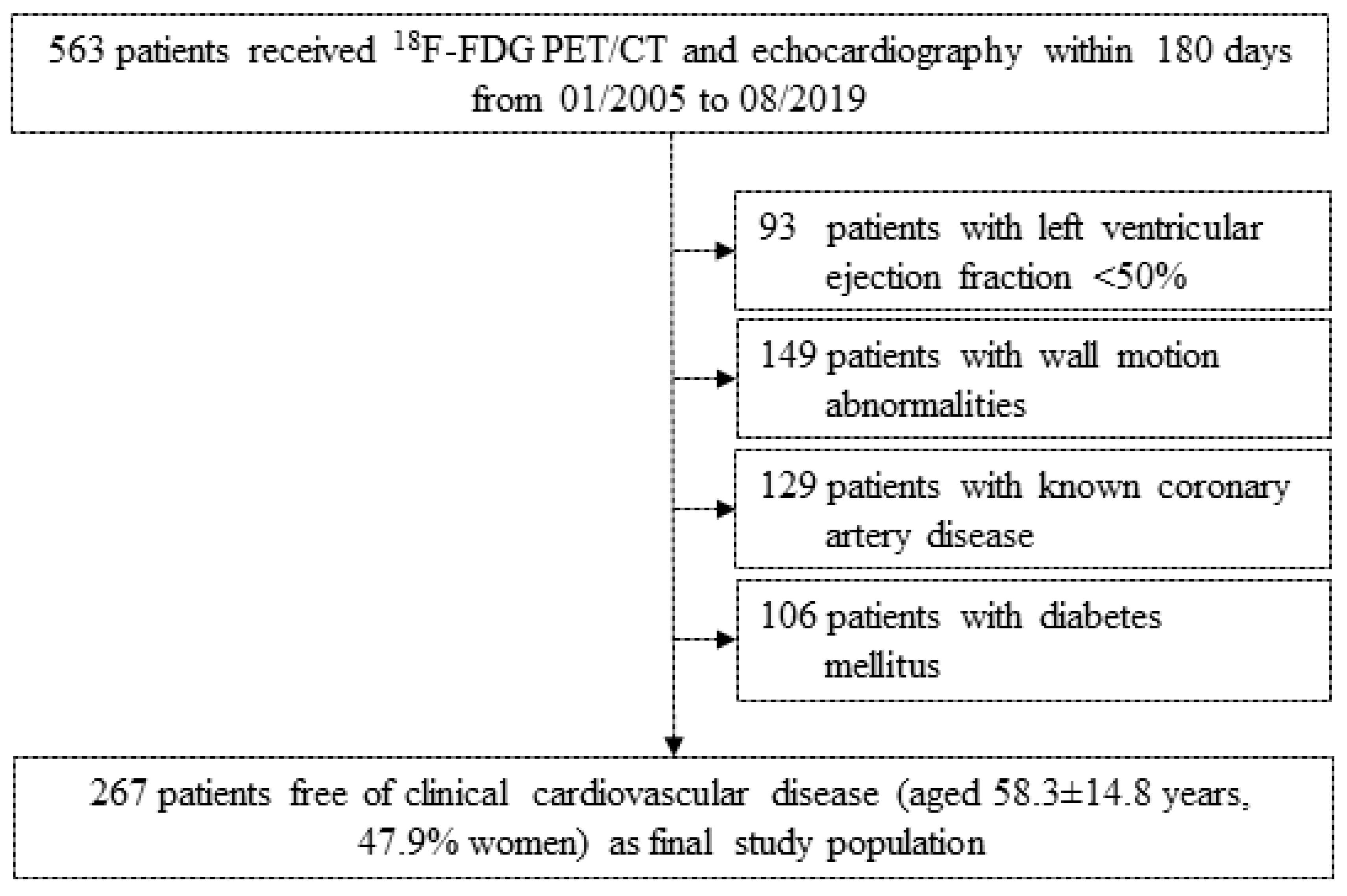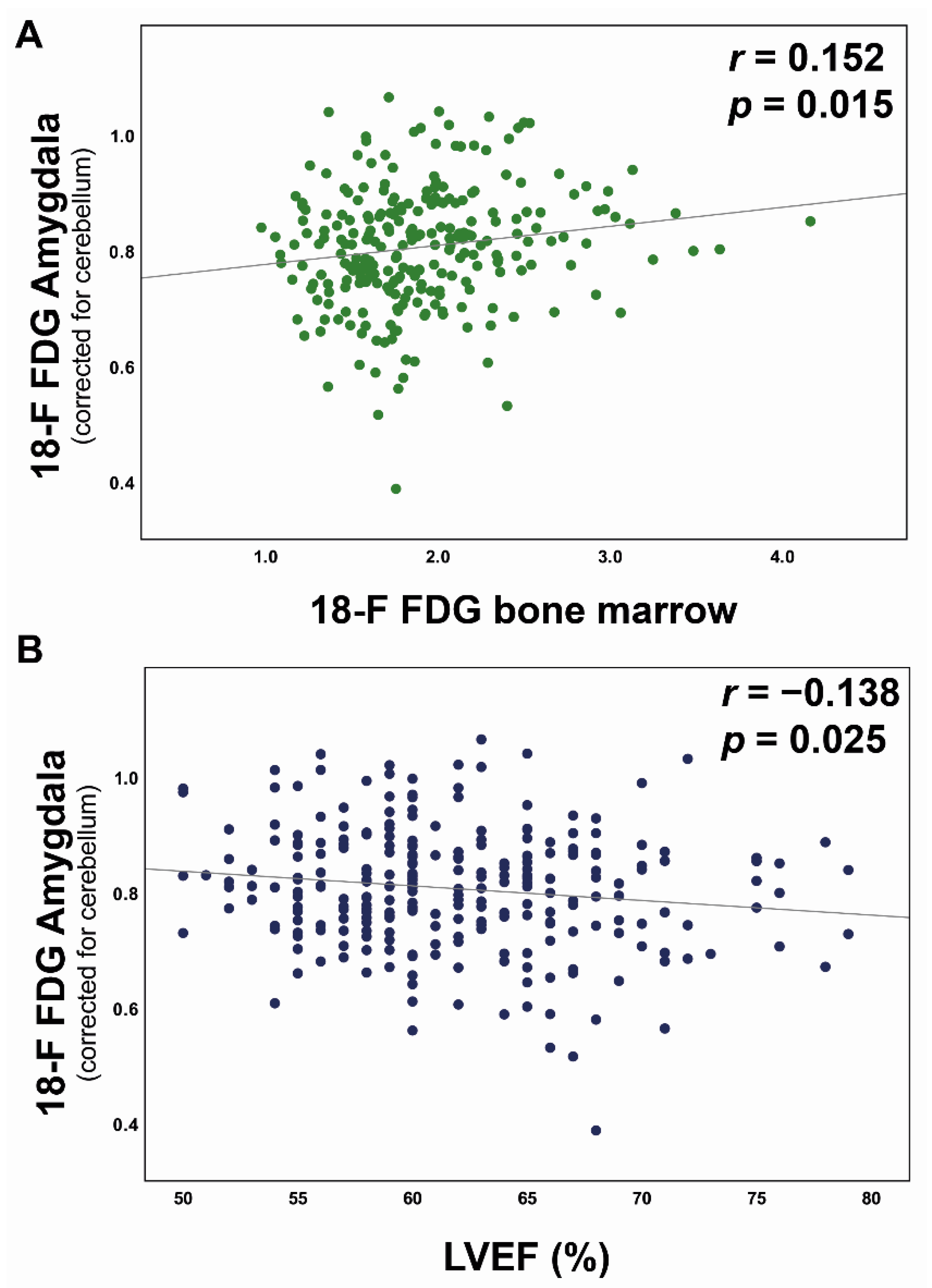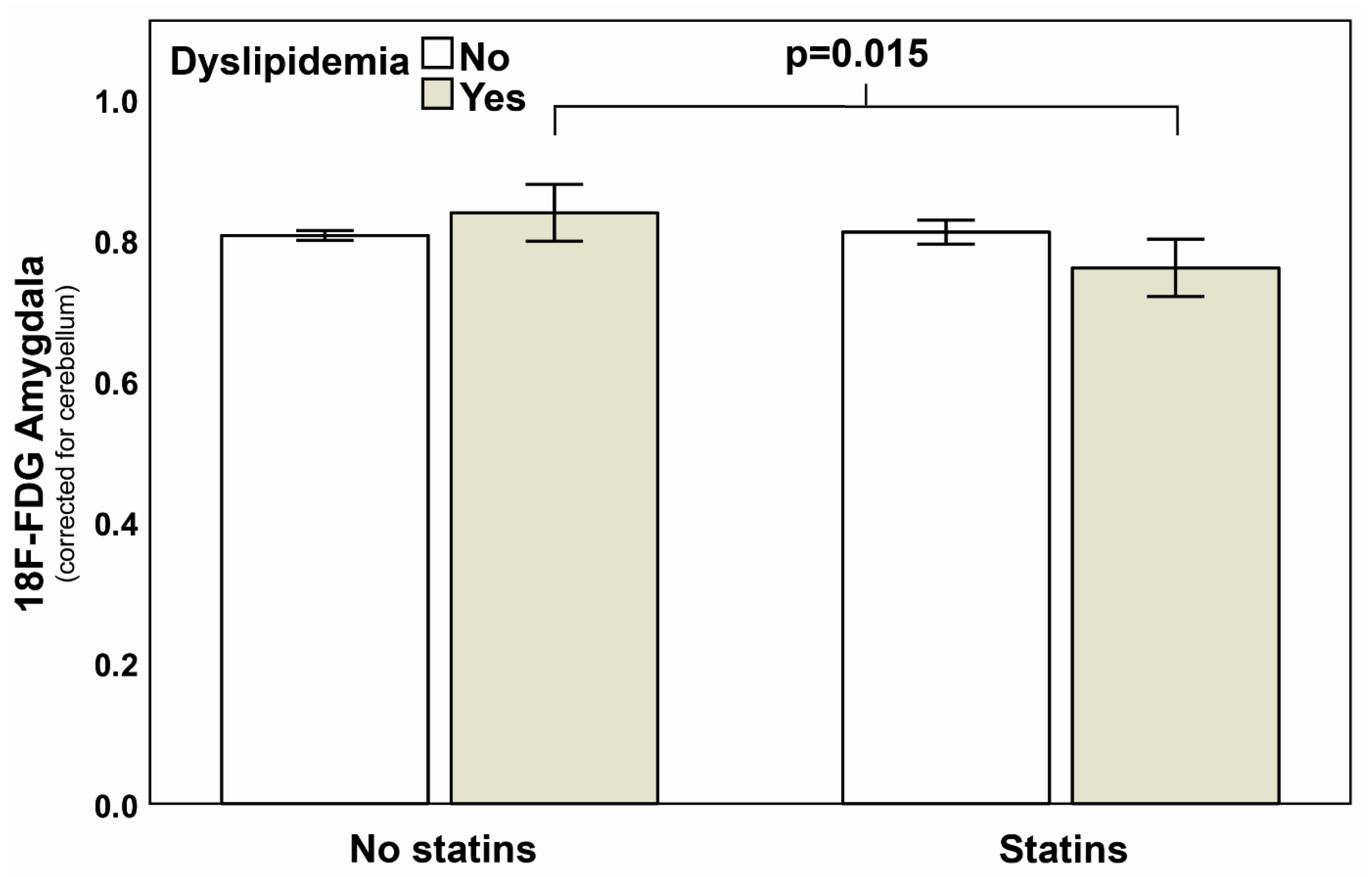Potential Impact of Statins on Neuronal Stress Responses in Patients at Risk for Cardiovascular Disease
Abstract
1. Introduction
2. Material and Methods
3. Results
4. Discussion
5. Conclusions
Author Contributions
Funding
Institutional Review Board Statement
Informed Consent Statement
Data Availability Statement
Acknowledgments
Conflicts of Interest
References
- Hansson, G.K. Inflammation, atherosclerosis, and coronary artery disease. N. Engl. J. Med. 2005, 352, 1685–1695. [Google Scholar] [CrossRef]
- Kalkman, D.N.; Aquino, M.; Claessen, B.E.; Baber, U.; Guedeney, P.; Sorrentino, S.; Vogel, B.; de Winter, R.J.; Sweeny, J.; Kovacic, J.; et al. Residual inflammatory risk and the impact on clinical outcomes in patients after percutaneous coronary interventions. Eur. Heart J. 2018, 39, 4101–4108. [Google Scholar] [CrossRef]
- Ridker, P.M.; Rifai, N.; Clearfield, M.; Downs, J.R.; Weis, S.E.; Miles, J.S.; Gotto, A.M., Jr. Measurement of C-reactive protein for the targeting of statin therapy in the primary prevention of acute coronary events. N. Engl. J. Med. 2001, 344, 1959–1965. [Google Scholar] [CrossRef] [PubMed]
- Fracassi, A.; Marangoni, M.; Rosso, P.; Pallottini, V.; Fioramonti, M.; Siteni, S.; Segatto, M. Statins and the Brain: More than Lipid Lowering Agents? Curr. Neuropharmacol. 2019, 17, 59–83. [Google Scholar] [CrossRef] [PubMed]
- Lagraauw, H.M.; Kuiper, J.; Bot, I. Acute and chronic psychological stress as risk factors for cardiovascular disease: Insights gained from epidemiological, clinical and experimental studies. Brain Behav. Immun. 2015, 50, 18–30. [Google Scholar] [CrossRef] [PubMed]
- Wang, S.S.; Yan, X.B.; Hofman, M.A.; Swaab, D.F.; Zhou, J.N. Increased expression level of corticotropin-releasing hormone in the amygdala and in the hypothalamus in rats exposed to chronic unpredictable mild stress. Neurosci. Bull. 2010, 26, 297–303. [Google Scholar] [CrossRef]
- Tawakol, A.; Ishai, A.; Takx, R.A.; Figueroa, A.L.; Ali, A.; Kaiser, Y.; Truong, Q.A.; Solomon, C.J.E.; Calcagno, C.; Mani, V.; et al. Relation between resting amygdalar activity and cardiovascular events: A longitudinal and cohort study. Lancet 2017, 389, 834–845. [Google Scholar] [CrossRef]
- LeDoux, J.E.; Iwata, J.; Cicchetti, P.; Reis, D.J. Different projections of the central amygdaloid nucleus mediate autonomic and behavioral correlates of conditioned fear. J. Neurosci. 1988, 8, 2517–2529. [Google Scholar] [CrossRef]
- Ross, R. Atherosclerosis—An inflammatory disease. N. Engl. J. Med. 1999, 340, 115–126. [Google Scholar] [CrossRef] [PubMed]
- Boellaard, R.; Delgado-Bolton, R.; Oyen, W.J.; Giammarile, F.; Tatsch, K.; Eschner, W.; Verzijlbergen, F.J.; Barrington, S.F.; Pike, L.C.; Weber, W.A.; et al. FDG PET/CT: EANM procedure guidelines for tumour imaging: Version 2.0. Eur. J. Nucl. Med. Mol. Imaging 2015, 42, 328–354. [Google Scholar] [CrossRef] [PubMed]
- Hammers, A.; Allom, R.; Koepp, M.J.; Free, S.L.; Myers, R.; Lemieux, L.; Mitchell, T.N.; Brooks, D.J.; Duncan, J.S. Three-dimensional maximum probability atlas of the human brain, with particular reference to the temporal lobe. Hum. Brain Mapp. 2003, 19, 224–247. [Google Scholar] [CrossRef] [PubMed]
- Fiechter, M.; Haider, A.; Bengs, S.; Marędziak, M.; Burger, I.A.; Roggo, A.; Portmann, A.; Schade, K.; Warnock, G.I.; Treyer, V.; et al. Sex-dependent association between inflammation, neural stress responses, and impaired myocardial function. Eur. J. Nucl. Med. Mol. Imaging 2020, 47, 2010–2015. [Google Scholar] [CrossRef] [PubMed]
- Goodman, S.N. STATISTICS. Aligning statistical and scientific reasoning. Science 2016, 352, 1180–1181. [Google Scholar] [CrossRef] [PubMed]
- Fiechter, M.; Haider, A.; Bengs, S.; Maredziak, M.; Burger, I.A.; Roggo, A.; Portmann, A.; Warnock, G.I.; Schade, K.; Treyer, V.; et al. Sex Differences in the Association between Inflammation and Ischemic Heart Disease. Thromb. Haemost. 2019, 119, 1471–1480. [Google Scholar] [CrossRef] [PubMed]
- Xiao, H.; Li, H.; Wang, J.J.; Zhang, J.S.; Shen, J.; An, X.B.; Zhang, C.-C.; Wu, J.-M.; Song, Y.; Wang, X.-Y.; et al. IL-18 cleavage triggers cardiac inflammation and fibrosis upon beta-adrenergic insult. Eur. Heart J. 2018, 39, 60–69. [Google Scholar] [CrossRef] [PubMed]
- Zeiser, R. Immune modulatory effects of statins. Immunology 2018, 154, 69–75. [Google Scholar] [CrossRef] [PubMed]
- Cesaro, A.; Bianconi, V.; Gragnano, F.; Moscarella, E.; Fimiani, F.; Monda, E.; Scudiero, O.; Limongelli, G.; Pirro, M.; Calabrò, P. Beyond cholesterol metabolism: The pleiotropic effects of proprotein convertase subtilisin/kexin type 9 (PCSK9). Genetics, mutations, expression, and perspective for long-term inhibition. Biofactors 2020, 46, 367–380. [Google Scholar] [CrossRef] [PubMed]



| Patient Baseline Characteristics | Total (n = 267) | Statin (n = 42) | No Statin (n = 225) | p-Value (Statin vs. No Statin) |
|---|---|---|---|---|
| Age (years), mean ± SD | 58.3 ± 14.8 | 66.1 ± 10.2 | 56.9 ± 15.1 | <0.001 |
| Hypertension, n(%) | 82(30.7) | 16(6.0) | 66(24.7) | 0.227 |
| Dyslipidemia, n(%) | 18(6.7) | 8(3.0) | 10(3.7) | 0.003 |
| Obesity, n(%) | 39(14.6) | 6(2.2) | 33(12.4) | 1.000 |
| Family history of CAD, n(%) | 3(1.1) | 1(0.4) | 2(0.7) | 0.403 |
| Smoking, n(%) | 41(15.4) | 7(2.6) | 34(12.7) | 0.816 |
| Alcohol, n(%) | 18(6.7) | 1(0.4) | 17(6.4) | 0.323 |
| LVEF (%), mean ±SD | 61.8 ± 5.8 | 61.6 ± 5.5 | 61.8 ± 5.9 | 0.829 |
| Blood glucose (mmol/L), mean ± SD | 5.6 ± 1.3 | 5.4 ± 0.9 | 5.7 ± 1.4 | 0.272 |
| Creatinine (µmol/L), mean ± SD | 102.3 ± 90.4 | 118.1 ± 123.7 | 99.6 ± 83.6 | 0.387 |
| CRP (mg/L), mean ± SD | 53.1 ± 68.9 | 63.2 ± 82.1 | 51.1 ± 66.4 | 0.454 |
| NT-proBNP (ng/L), mean ± SD | 1553 ± 2468 | 2062 ± 3383 | 1468 ± 2367 | 0.664 |
| Neutrophiles (×103/µL), mean ± SD | 5.85 ± 3.51 | 6.62 ± 3.41 | 5.72 ± 3.53 | 0.300 |
| Lymphocytes (×103/µL), mean ± SD | 1.34 ± 0.74 | 1.32 ± 0.66 | 1.34 ± 0.75 | 0.900 |
| 18F-FDG bone marrow (SUV), mean ± SD | 1.91 ± 0.50 | 1.85 ± 0.43 | 1.92 ± 0.51 | 0.424 |
| 18F-FDG amygdala (SUV), mean ± SD | 0.81 ± 0.10 | 0.80 ± 0.10 | 0.81 ± 0.10 | 0.722 |
Publisher’s Note: MDPI stays neutral with regard to jurisdictional claims in published maps and institutional affiliations. |
© 2021 by the authors. Licensee MDPI, Basel, Switzerland. This article is an open access article distributed under the terms and conditions of the Creative Commons Attribution (CC BY) license (https://creativecommons.org/licenses/by/4.0/).
Share and Cite
Diggelmann, F.; Bengs, S.; Haider, A.; Epprecht, G.; Beeler, A.L.; Etter, D.; Wijnen, W.J.; Portmann, A.; Warnock, G.I.; Treyer, V.; et al. Potential Impact of Statins on Neuronal Stress Responses in Patients at Risk for Cardiovascular Disease. J. Pers. Med. 2021, 11, 261. https://doi.org/10.3390/jpm11040261
Diggelmann F, Bengs S, Haider A, Epprecht G, Beeler AL, Etter D, Wijnen WJ, Portmann A, Warnock GI, Treyer V, et al. Potential Impact of Statins on Neuronal Stress Responses in Patients at Risk for Cardiovascular Disease. Journal of Personalized Medicine. 2021; 11(4):261. https://doi.org/10.3390/jpm11040261
Chicago/Turabian StyleDiggelmann, Flavia, Susan Bengs, Achi Haider, Gioia Epprecht, Anna Luisa Beeler, Dominik Etter, Winandus J. Wijnen, Angela Portmann, Geoffrey I. Warnock, Valerie Treyer, and et al. 2021. "Potential Impact of Statins on Neuronal Stress Responses in Patients at Risk for Cardiovascular Disease" Journal of Personalized Medicine 11, no. 4: 261. https://doi.org/10.3390/jpm11040261
APA StyleDiggelmann, F., Bengs, S., Haider, A., Epprecht, G., Beeler, A. L., Etter, D., Wijnen, W. J., Portmann, A., Warnock, G. I., Treyer, V., Grämer, M., Todorov, A., Mikail, N., Rossi, A., Fuchs, T. A., Pazhenkottil, A. P., Buechel, R. R., Tanner, F. C., Kaufmann, P. A., ... Fiechter, M. (2021). Potential Impact of Statins on Neuronal Stress Responses in Patients at Risk for Cardiovascular Disease. Journal of Personalized Medicine, 11(4), 261. https://doi.org/10.3390/jpm11040261








